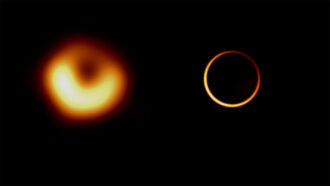The first image of a black hole may conceal treasure — but physicists disagree about whether it’s been found.
A team of scientists say they’ve unearthed a photon ring, a thin halo of light around the supermassive black hole in the galaxy M87. If real, the photon ring would provide a new probe of the black hole’s intense gravity. But other scientists dispute the claim. Despite multiple news headlines suggesting the photon ring has been found, many physicists remain unconvinced.
Unveiled in 2019 by scientists with the Event Horizon Telescope, or EHT, the first image of a black hole revealed a doughnut-shaped glow from hot matter swirling around the black hole’s dark silhouette (SN: 4/10/19). But according to Einstein’s general theory of relativity, a thinner ring should be superimposed on that thick doughnut. This ring is produced by photons, or particles of light, that orbit close to the black hole, slung around by the behemoth’s gravity before escaping and zinging toward Earth.
Thanks to this circumnavigation, the photons should provide “a fingerprint of gravity,” more clearly revealing the black hole’s properties, says astrophysicist Avery Broderick of the University of Waterloo and the Perimeter Institute for Theoretical Physics in Canada. He and his colleagues, a subset of scientists from the EHT collaboration, used a new method to tease out that fingerprint, they report in the Aug. 10 Astrophysical Journal.
Creating images with EHT isn’t a simple point-and-shoot affair (SN: 4/10/19). Researchers stitch together data from EHT’s squad of observatories scattered across the globe, using various computational techniques to reconstruct an image. Broderick and colleagues created a new black hole image assuming it featured both a diffuse emission and a thin ring. On three out of four days of observations, the data better matched an image with the added thin ring than one without the ring.
But that method has drawn harsh criticism. “The claim of a photon ring detection is preposterous,” says physicist Sam Gralla of the University of Arizona in Tucson.
A main point of contention: The photon ring is brighter than expected, emitting around 60 percent of the light in the image. According to predictions, it should be more like 20 percent. “That’s a giant red flag,” says physicist Alex Lupsasca of Vanderbilt University in Nashville. More light should come from the black hole’s main glowing doughnut than from the thin photon ring.
This unexpected brightness, Broderick and colleagues say, occurs because some of the light from the main glow gets lumped in with the photon ring. So the ring’s apparent brightness doesn’t depend only on the light coming from the ring. The researchers note that the same effect appeared when testing the method on simulated data.
But that mishmash of purported photon ring light with other light doesn’t make for a very convincing detection, critics say. “If you want to claim that you’ve seen a photon ring, I think you have to do a better job than this,” says astrophysicist Dan Marrone of the University of Arizona, a member of the EHT collaboration who was not a coauthor on the new paper.
The new result suggests only that an added thin ring gives a better match to the data, Marrone says, not whether that shape is associated with the photon ring. So it raises the question of whether scientists are seeing a photon ring at all, or just picking out an unrelated structure in the image.
But Broderick argues that the features of the ring — the fact that its size and location are as expected and are consistent day-to-day — support the photon ring interpretation.
Meanwhile, in a similar, independent analysis, Gralla and physicist Will Lockhart, also of the University of Arizona, find no evidence for a photon ring, they report in a paper submitted August 22 at arXiv.org. Their analysis differed from Broderick and colleagues’ in part because it limited how bright the photon ring could be.
To convincingly detect the photon ring, some scientists propose adding telescopes in space to the EHT’s crew of observatories (SN: 3/18/20). The farther apart the telescopes in the network are, the finer details they may be able to pick out — potentially including the photon ring.
“If there were a photon ring detection,” Lupsasca says, “that would be the best thing in physics this year, if not for many years.”


